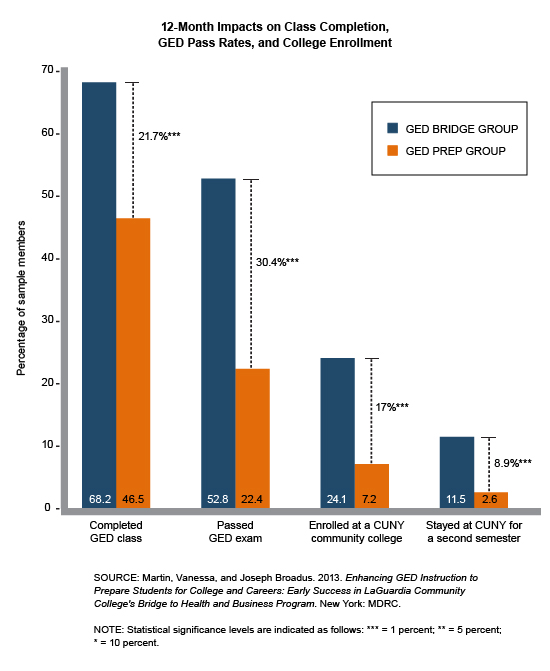A Career Approach to GED Instruction
Nearly 39 million adults in the United States lack a valid high school credential and face a significant barrier to both higher education and employment opportunities. High school equivalency exams, primarily the General Educational Development (GED) exam, are the primary gateway to college for high school dropouts,[1] but relatively few people are able to pass these exams each year, and most of those who obtain a credential fail to complete even one year of postsecondary education or training. Adult education policymakers and practitioners are searching for ways to improve the quality of GED preparation programs and create paths from those programs to postsecondary education or training, and ultimately to careers.
One innovative approach called career pathways aims to improve students’ basic educational and occupational skills while they earn high school and technical credentials as well as postsecondary certifications or degrees. This approach connects progressive levels of education, training, credentials, and support services for specific occupations in a way that maximizes the progress of individuals with varying abilities and needs. It helps people earn marketable credentials, engage in education and employment, and achieve economic success. It enlists employers and helps meet their workforce needs; it also helps states and communities strengthen their workforces and economies. This approach is not simply a new model for education; it aims to transform whole systems.[2]
MDRC is currently evaluating a program model that includes the basic tenets of the career pathway approach: The career-focused GED curriculum model aims to improve high school credentialing and college entry rates. It offers a contextualized, career-focused GED curriculum, while supporting students in their transition to college or training. In this model, the “pathway” is sequential in that it focuses on first getting students the high school credential and then helping them transition to college. It is especially useful in states where a high school credential is required to enroll in public postsecondary institutions.
MDRC has evaluated the contextualized, career-focused GED curriculum model once already at LaGuardia Community College in New York City, through its program called GED Bridge to Health and Business. The results there were very positive. It is now evaluating a similar version at Northeast Wisconsin Technical College. The model has four main elements:
- A career-focused curriculum. Programs select an occupational area where workers are in high demand regionally, and everything is taught in the context of that career.
- Direct connections to postsecondary institutions. To reinforce the expectation that students will go on to college and ultimately to careers, programs are either offered on college campuses or in some other way give students exposure to a college environment. The courses themselves are also designed to resemble college courses in various ways.
- Managed cohort enrollment. To underscore the connection with the college environment and create a cohesive, supportive learning community, students are only allowed to enroll at particular times, for example at the beginning of a semester. (In contrast, many GED preparation programs allow students to enter and exit courses at any time.)
- Support services to help students enter college and a career. Advisers guide students through the college application process while the program introduces students to college-level expectations. They also work with students in and out of the classroom on career assessments, and provide them with individual guidance to help them choose a career path.
These are general principles, designed to be adapted to local contexts and an ever-changing economy. For example, the occupations in demand locally will vary from region to region, and may also vary over time within a region. A career-focused curriculum will have to be adjusted accordingly. The LaGuardia GED Bridge program was tested rigorously over four semesters — fall 2010, spring 2011, fall 2011, and spring 2012. Almost 400 students were assigned, at random, to either GED Bridge or to a more traditional GED Prep course. About half of these students read at a seventh- or eighth-grade level when they enrolled and about half were receiving some form of public assistance. At every stage, GED Bridge improved these students’ results (see figure): GED Bridge students were much more likely to finish the GED Bridge course, to pass the GED exam, to enroll in college, and to reenroll for a second semester.

MDRC is interested in evaluating other program models along the career pathway continuum, such as those that have an integrated or sequential design that includes adult basic education and occupational skills training. Results from the evaluation at Northeast Wisconsin Technical College should begin to be available in 2016.
[1]For simplicity, the term “GED” is used generically to refer to an alternative high school credential, though some states offer equivalents to a high school diploma that go by other names.
[2]Alliance for Quality Career Pathways, Shared Vision, Strong Systems (Washington, DC: Alliance for Quality Career Pathways/CLASP, 2014).







